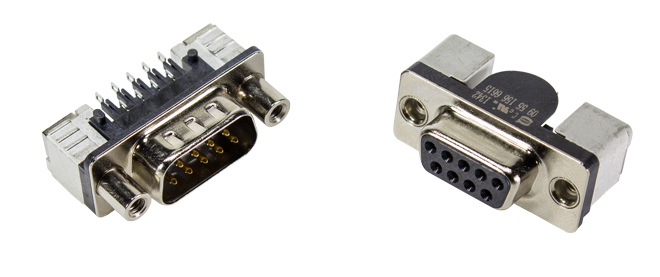In the realm of modern electronics, connectivity is of paramount importance. Whether it’s transferring data, powering devices, or establishing communication channels, connectors play a vital role in enabling seamless connections. One such connector that has stood the test of time is the D Sub connector. The D Sub connector, also known as the D-Subminiature connector, has been a mainstay in the electronics industry for decades. Its versatility and reliability have made it a popular choice in various applications, ranging from computers and telecommunications to industrial machinery and automotive systems.
D Sub connectors are named after their distinctive “D” shape, which ensures a secure and reliable connection. These connectors consist of two rows of pins or sockets that are housed within a metal or plastic shell. The number of pins can vary, with standard configurations available in 9, 15, 25, 37, and 50 pins. This flexibility allows for different data transmission capabilities, making D-sub connectors suitable for a wide range of applications.
The primary advantage of D Sub connectors lies in their ability to transmit both power and data signals. They are commonly used in computer interfaces, such as serial ports, parallel ports, and VGA connectors. Additionally, D Sub connectors can be found in telecommunications equipment, where they facilitate the transmission of voice and data signals. Their robust design and sturdy construction make them ideal for industrial applications, where they can withstand harsh environments and provide reliable connections.
Demystifying M12 Connectors: The Backbone of Industrial Connectivity
In industrial settings, where robustness and reliability are critical, M12 connectors have become the backbone of connectivity. These connectors, named after their 12mm circular shell, are widely used in automation, manufacturing, and process control applications. M12 connectors are particularly suited for harsh environments, where they protect against dust, liquids, and vibration.
M12 connectors come in different configurations, including 3, 4, 5, 8, and 12 pins. The number of pins determines the type of signals that can be transmitted, ranging from power and data to Ethernet and Fieldbus signals. This versatility makes M12 connectors an integral part of industrial networks, ensuring seamless communication between devices and systems.
One of the key features of M12 connectors is their robust design. The connectors are typically made of high-quality materials, such as stainless steel or ruggedized plastic, which provide excellent resistance to environmental factors. Additionally, M12 connectors often incorporate IP67 or IP68 ratings, ensuring protection against dust, water, and other contaminants. These features make M12 connectors suitable for challenging environments, such as manufacturing plants, where reliability is crucial.
Choosing the Right Connector for Your Application
Selecting the appropriate connector for your specific application requires careful consideration of various factors. Both D Sub and M12 connectors have their unique strengths and are suitable for different use cases. Here are some key considerations to help you make an informed decision:
- Application Requirements: Start by assessing the specific needs of your application. Consider the type of signals you need to transmit, the environmental conditions the connectors will be exposed to, and any industry or regulatory standards that must be met.
- Data Transmission: If your application involves high-speed data transfer or complex protocols, D Sub connectors may be a better choice. They offer a wide range of options for data transmission, including RS-232, RS-485, and USB. On the other hand, M12 connectors are commonly used in industrial Ethernet and Fieldbus applications, where reliable and secure data transmission is paramount.
- Environmental Considerations: The operating environment is a crucial factor when selecting connectors. D Sub connectors are well-suited for office and indoor environments, while M12 connectors excel in rugged and harsh conditions. Consider factors such as temperature extremes, exposure to moisture, dust, and vibrations, as well as the ingress protection (IP) rating required for your application.
- Installation and Maintenance: Ease of installation and maintenance should also be taken into account. D Sub connectors are relatively easy to install and require minimal maintenance. However, M12 connectors, with their robust design and IP ratings, may offer easier installation and more straightforward maintenance in challenging environments.
By carefully evaluating these factors, you can choose the connector that best suits your application’s requirements and ensures reliable connectivity.
Best Practices for Installation and Maintenance
Proper installation and maintenance are essential for ensuring the longevity and reliability of D Sub and M12 connectors. Here are some best practices to consider:
- Careful Handling: Handle connectors with care to avoid any physical damage. Avoid excessive force when connecting or disconnecting them, and ensure proper alignment to prevent bent pins or damaged contacts.
- Cleanliness: Keep connectors clean and free from dust, dirt, and moisture. Use a lint-free cloth or compressed air to remove any contaminants. Avoid using abrasive materials or excessive cleaning agents that may cause damage.
- Secure Connections: Ensure connectors are securely fastened to prevent any accidental disconnections. Check the tightness of screws or locking mechanisms regularly, especially in high-vibration environments.
- Regular Inspection: Perform regular visual inspections to identify any signs of wear, damage, or corrosion. Replace connectors that show signs of deterioration to prevent signal loss or system failures.
- Proper Cable Management: Proper cable management is crucial for maintaining the integrity of the connector. Avoid excessive bending, twisting, or pulling of cables, as this can strain the connectors and lead to signal degradation.
By following these best practices, you can maximise the performance and lifespan of your D Sub and M12 connectors, ensuring reliable and uninterrupted connectivity.
Conclusion
Connectivity is the lifeblood of modern electronics, and D Sub and M12 connectors play a crucial role in enabling seamless connections. Understanding their unique characteristics and selecting the right connector for your application is essential for ensuring reliable performance. By following best practices for installation and maintenance, you can unlock the full potential of these connectors and achieve robust and uninterrupted connectivity in your electronic systems.






